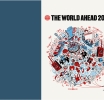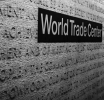What Will 2026 Be Like? An Analytical Analysis of The Economist's Puzzle

What Will 2026 Be Like? An Analytical Analysis of The Economist's Puzzle
2026 emerges as a year shaped by geopolitical confrontation, technological escalation, systemic fatigue, and symbolic dates. The Economist's cover is not a forecast but a visual map of risks, pointing to a world in which political blocs collide, old structures crack, and global transitions accelerate.
The annual World Ahead cover from The Economist traditionally functions as a visual code — a dense cluster of symbols that reflects the forces shaping the coming year. Rather than direct predictions, the cover offers an interpretative field: a place where political pressure points, unresolved conflicts, leadership dynamics, technological shifts, and macrohistorical markers converge in a single image.
The 2026 edition follows the same principle. Your description already outlines several key elements: color dualism, depictions of world leaders, military themes, references to US history, and imagery of trade, rockets, drones, and fragmented structures.
This material distills everything into a systematic, logical analysis—without speculation or attempts to guess the editors' "true intent." Only the structure of the image and its possible layers of meaning.
The 2026 edition follows the same principle. Your description already outlines several key elements: color dualism, depictions of world leaders, military themes, references to US history, and imagery of trade, rockets, drones, and fragmented structures.
This material distills everything into a systematic, logical analysis—without speculation or attempts to guess the editors' "true intent." Only the structure of the image and its possible layers of meaning.

What Will 2026 Be Like? An Analytical Analysis of The Economist's Puzzle
Red and Blue: Dualism of the Global System
The central composition is built around the clash of two colors—red and blue. In your description, this is no longer just an aesthetic detail, but a symbolic axis that underpins the entire cover message. Red is perceived as impulse and anxiety, a sign of turbulence returning to the global agenda. It resembles a visual marker of risk, indicating that the world is entering another cycle of instability.Blue, on the other hand, seems to embody rationality, technological control, and the dry logic of systems. It can be read as a metaphor for digital infrastructures, bureaucracy, and algorithmic governance.
Together, these colors create an image of a world in which emotional-political impulsiveness and technocratic coldness don't interact, but rather clash. The result is a model of reality in which every decision is the product of a conflict between emotion and calculation, rather than their synthesis.
This approach conveys the feeling that 2026 will not be a year of harmonization, but rather a field of tension between two incompatible logics.
White Background: Sterility and Experimental Space
The white background enhances the contrast, acting as a neutral laboratory environment where new political and technological models are tested. Unlike the chaotic center, the background seems deliberately devoid of detail, creating the feeling of a sterile experimental zone.This can be interpreted as an indication of the transitional nature of the moment: familiar structures are receding into the past, while new ones have not yet taken shape. The white space makes the central chaos more visible, emphasizing that we are not observing a stable system, but a high-risk experimental field.
Zelensky: A Figure Positioned in the Epicenter of Conflict
The cover features a figure you interpret as Zelensky. He's surrounded by drones, missiles, and destruction—a visual environment that instantly conveys a constant state of threat.A distinct detail is the lack of a clearly defined face. This makes the figure symbolic rather than personalized. This approach transforms the leader not into a specific individual, but into an archetype: the image of a state holding its ground in a protracted and debilitating conflict.
The scene you described, with the "foreigner" handing over a red object, lends additional ambiguity to the scene, although the precise meaning of this symbol is unclear. But the overall visual context sets the tone: the Ukrainian theme remains a key one, and 2026, according to the composition, will not bring about its disappearance from the global agenda.
Trump, Putin, Xi and the Symbolic Leaders' Cluster
The group of silhouettes representing world leaders is designed schematically—they are no longer portraits, but symbols. This format underscores the idea that in the global political game of 2026, it's not the individuals who matter, but the systems they represent.The crossed swords between the figures create a sense of ongoing conflict. This is not a promise of war, but merely a visual sign of a lack of consensus.
Trump's figure—with his red cap and sharply defined movements—is read as an image of political unpredictability and impulsive force. The people around him, whom you describe as "zombie-like," reinforce the sense that the global stage in 2026 could become an arena for unconventional or destabilizing factors.
The composition looks like a map of political centers that are not moving closer to each other, but rather are moving further and further apart.
“250”: The US Anniversary as a Systemic Marker
The US anniversary is a significant event, and the cover uses it not as a celebration, but as a symbolic marker of the completion of a historical cycle.The number "250" appears as a reminder that the key political and institutional models that have defined the world system since the 18th century have reached a point of re-evaluation.
The cake is presented as a multi-layered structure—it resembles an archive, with each layer corresponding to a historical period. This is a visual hint that global systems can be disassembled, reassembled, or reimagined.
The Hand With Handcuffs: Pressure Between Old and New Orders
The hand emerging from the anniversary cake appears as the main dramatic element. It symbolizes not victory, but resistance—an effort to break through old limitations.The handcuff reminds us that the old structures still hold, but are no longer capable of ensuring control. The rockets soaring upward and the capsule falling downward create a vertical axis where some systems begin their journey while others complete their cycle.
This set of images suggests that 2026 could be a moment of overload: old models continue to function, but the world is already moving toward new political and technological logics.
Trade and Technology: Ships, Containers, Drones
The symbolism of global trade appears through the container ship. Containers, assembled in the shape of a flag, point to the politicization of economic flows. This reflects the current state of global trade, which is no longer perceived as a neutral sphere but has become part of the geopolitical toolkit.Drones and satellites above the stage create a sense of total surveillance. It's a sign of a world in which digital surveillance, military technology, and data control are becoming not an add-on, but a central element of international relations.
The cover of The World Ahead 2026 isn't a prediction. It's a map of risks. And when all the elements are brought together, a vision of the year emerges, defined by several key tensions.
2026 looks like a moment:
• protracted unresolved conflicts;
• increasing competition between political poles;
• growing role of military and surveillance technologies;
• systemic fatigue of old institutions;
• instability of global trade and supply chains;
• pressure of historical symbolism and the end of a long cycle.
The key message that can be drawn from the visual code is that
2026 is a year of transition, one in which stable boundaries are absent. Tension, competition, and rethinking of previous models are becoming the new norm.
By Miles Harrington
November 19, 2025
Join us. Our Telegram: @forexturnkey
All to the point, no ads. A channel that doesn't tire you out, but pumps you up.
November 19, 2025
Join us. Our Telegram: @forexturnkey
All to the point, no ads. A channel that doesn't tire you out, but pumps you up.









Report
My comments